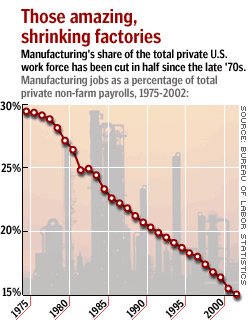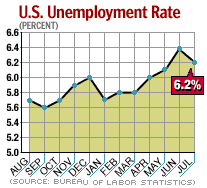NEW YORK (CNN/Money) -
The Bush administration has launched a campaign to recover some of the millions of U.S. manufacturing jobs that have been lost in recent years, but many economists believe these efforts will be futile; most of these jobs are simply never coming back.
"I understand for a full recovery, to make sure people can find work, that manufacturing must do better," Bush told a crowd of workers in Richfield, Ohio, in a Labor Day speech. "And we've lost thousands of jobs in manufacturing."

Actually, since March 2001, when the National Bureau of Economic Research said the latest recession began, manufacturing has lost 2.3 million jobs, making up the bulk of the 2.7 million total jobs the economy has lost.
But manufacturing layoffs began long before the recession; since hitting its latest peak in March 1998, manufacturing employment has shrunk by 3 million jobs. In fact, the number of people employed in manufacturing in July 2003 -- 14.6 million -- was almost exactly the same as the number employed in manufacturing in July 1945.
In his speech, Bush cited the steady outflow of manufacturing jobs overseas, especially to China, where labor costs are cheap, and he called for a "fair playing field when it comes to trade" -- a not-so-subtle call for China to float the value of its currency, the yuan, which is now tied to the U.S. dollar and may be undervalued by as much as 40 percent.
U.S. manufacturers say this imbalance keeps Chinese goods cheaper, making them more competitive overseas and putting U.S. exports at a disadvantage.
| Related stories
|

|
|
|
|
"It is time for the administration to get tough with the Chinese," Jerry Jasinowski, president of the National Association of Manufacturers, said last week.
Thanks in part to such pressure from U.S. companies, Treasury Secretary John Snow went to Beijing this week to ask China's government to float the yuan.
Reports have varied about the success of Snow's mission, but they haven't exactly been good. The Wall Street Journal said China was unlikely to float its currency at all, while the Associated Press and the Washington Post said China had promised to make its currency more flexible -- some day -- but offered no timetable for doing so.
But, as the Bush administration is probably aware, China was never going to cut its currency completely loose right away, owing to the massive disruption such a move might cause.
"If China was to completely get rid of its currency peg, and the yuan became completely convertible, it would fall under pressure," said Ashraf Laidi, chief currency analyst at MG Financial Group in New York. "It would become another Thai baht," a currency that was slammed by speculative selling in 1997, causing a crisis that spread to other Asian nations.
Scapegoating China
Instead, Laidi and other analysts said, China is more likely to build up its financial markets through liberalization and slowly give its currency more rope.
As part of the requirement for its entry into the World Trade Organization, China already is required to enact some trade reforms by 2005, which should help liberalize its markets. That liberalization could be accompanied by some currency reform, which could be at least help the rest of the world's economy a little bit, according to some analysts.

"China has a depressing effect on prices across the globe, partly because of the currency undervaluation," said Anindya Chatterjee, emerging markets strategist at IDEAglobal.com Ltd. "Affecting the currency will change the cost of capital and labor."
Other analysts aren't so sure. In a July research note entitled "The Scapegoating of China," Morgan Stanley chief economist Stephen Roach said China's real strengths lie in its infrastructure, its quality control, its "passion for and commitment to reform" and other assets unrelated to currency value.
"I honestly believe that if China were to revalue [its currency] upward by 10 percent -- a change I do not expect nor advise -- its exports would suffer minimal loss of market share," Roach said.
Policy misdirection?
In his Labor Day speech, Bush also promised the creation of at least one guaranteed new U.S. job -- an assistant secretary at the Commerce Department to focus on manufacturing, "to make sure our manufacturing job base is strong and vibrant."
Commerce Secretary Don Evans is scheduled to release details of the administration's plan to fix manufacturing on Sept. 15, but the Washington Post reported Wednesday that there are "hints" it will be little more than a repackaging of some older policy proposals.
In any event, it seems unlikely the administration will be able to reverse the steady decline of manufacturing as a function of the total U.S. economy -- in 1946, 32 percent of all U.S. jobs were in manufacturing. Now, just 12 percent are in factories.
Some of this has to do with China and other sources of cheap labor, but much of it has to do with productivity gains, or the ability of factories to use technology to make more goods with fewer workers. Though the process is painful now, economists said, it should pay off in higher standards of living in the future.
"As we learned in Economics 101, a declining manufacturing sector is part of the normal process as an economy develops," Wachovia Securities economist Matthew Ellis wrote in a recent research note that called for policy makers to focus on re-training workers and avoid protectionist policies -- such as last year's steel tariff -- that could be harmful in the long run.

|

